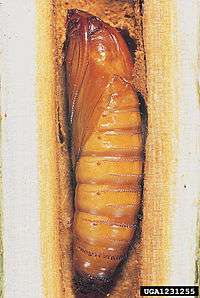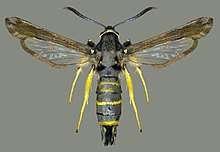Paranthrene tabaniformis
Paranthrene tabaniformis, the dusky clearwing, is a moth of the family Sesiidae. It is found in the Palearctic and Nearctic realms.

Larva

Exit hole

Pupa
| Paranthrene tabaniformis | |
|---|---|
 | |
| Scientific classification | |
| Kingdom: | Animalia |
| Phylum: | Arthropoda |
| Class: | Insecta |
| Order: | Lepidoptera |
| Family: | Sesiidae |
| Genus: | Paranthrene |
| Species: | P. tabaniformis |
| Binomial name | |
| Paranthrene tabaniformis (Rottemburg, 1775) | |
| Synonyms | |
| |
The wingspan is c. 30 mm. The length of the forewings is c. 14 mm. Meyrick describes it - Head with white vertical bar before each eye, and yellow posterior ring. Abdomen with yellow rings on 2, 4, 6, and sometimes 7. Middle and posterior tibiae orange, blackbanded.Forewings rather dark fuscous, with elongate obscure hyaline patch towards base; costal streak violet-blackish.Hindwings hyaline ; veins and termen dark fuscous.[1] The moth flies from May to August depending on the location.
The larvae feed on poplar, and sometimes on sea-buckthorn and willow.
Subspecies
- Paranthrene tabaniformis tabaniformis
- Paranthrene tabaniformis kungessana (Alpheraky, 1882)
- Paranthrene tabaniformis synagriformis (Rambur, [1866])
gollark: You can do it. It's just harder.
gollark: It's the node.js libraries and implementation.
gollark: It's not the language.
gollark: "I want all my C code to be like what WHY outputs. Why won't X language do this"
gollark: Blocking IO it be slow, yo.
References
- Meyrick, E., 1895 A Handbook of British Lepidoptera MacMillan, London pdf

This article is issued from Wikipedia. The text is licensed under Creative Commons - Attribution - Sharealike. Additional terms may apply for the media files.